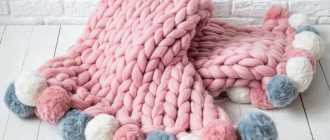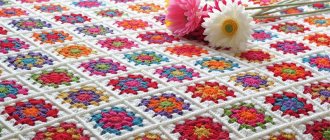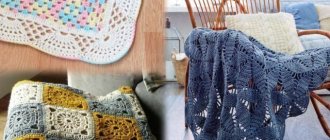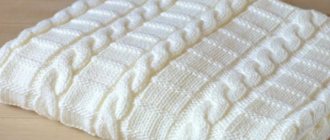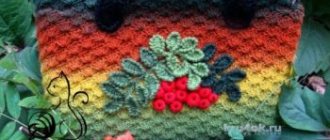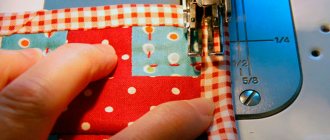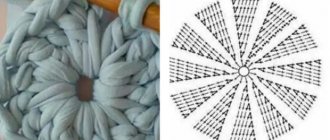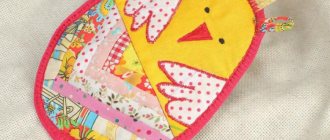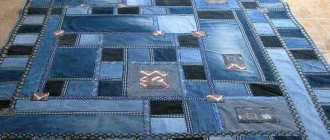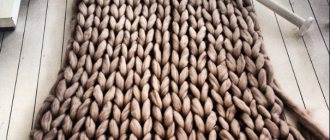For the second year in a row, chunky knitted blankets are filling the country’s Instagrams, and the trend for knitting in the interior has haunted me this fall.
I remember when I was studying at the Academy of Design and doing my homework about knitting as one of the trends, I was scrolling through pictures on Pintrest with blankets made from large yarn, but it didn’t even occur to me that you could knit these yourself. It seemed like these were some cool, inaccessible designer pieces.
But soon I began to come across posts on foreign blogs about hand knitting. Shtoa?! With your hands? So it is possible?
It turns out that yes. Very thick yarn is taken and hands are used instead of knitting needles.
Share with friends
- 3
- 3
Soft, airy, almost weightless – this hand-made, large-knit blanket has captivated fans of knitted art! Stylish, cozy blankets invite you to wrap yourself in a warm cloudy embrace on a gloomy morning or warm up on a cool evening...
The idea for the original knitting technique came from the Americans: the Modern Wool company started with blankets, bedspreads and pillows, but gradually switched to scarves, hats and snoods. A unique method of processing wool allows you to create a feeling of slight negligence and frayed threads. Do you think it’s impossible to create Gulliver’s loops from natural wool?! Oh, how wrong you are! Merino sheep wool lends itself well to processing, so the loops are even and smooth. Acrylic thread is in no way inferior in quality to natural wool, and the cost varies significantly.
Chunky knit blankets in basic shades
Magnificent knitted blankets made of merino wool or soft acrylic will complement the interior in Scandinavian, Provence and country styles. Giant loops create the most delicate fabric, which can be classic and strict, playful and openwork, sophisticated and stylish - it all depends on the imagination of the craftswoman.
Hand made is becoming more and more popular every day; it is a mistake to think that knitting is the lot of old ladies. Not at all! Simple large knitting of local colors is a trend for 2016-2017. Cool blue, rich red, rich green, pure purple, authentic white and black - win-win options! In addition, natural shades of mint, cold chocolate, and coffee with milk are in fashion. Muted coral, dusty blue and dirty pink will fit perfectly into any interior.
Chunky knit blanket in a Scandinavian interior
A do-it-yourself coarse knitted blanket or blanket will enliven a sofa in the living room and a bed in the bedroom, become a cozy cocoon for those who like to be alone, and turn into a children's rug for playing on the floor. Wear-resistant materials allow you to use a knitted blanket in any conditions. Believe me, even the most lively baby, once in the arms of gentle “lamps,” will not want to be capricious.
Is it possible to connect this miracle of designer imagination? It’s not difficult to create a large knit blanket with your own hands, however, the knitting needles are different from ordinary ones - Gulliver’s sizes impress even experienced knitters! But nothing is impossible for talent! Merino wool knitted creations are nothing like “grandmother’s” knitting.
Merino wool blanket for a cozy atmosphere in the home
Blankets made from thick yarn - elegant luxury of comfort.
The most successful purchase for your home will be a merino blanket. Finished products are found in the collection of the American brand Modern Wool. But prices for branded goods are steep, and delivery will cost a hefty sum. It is much more interesting and cheaper to knit a product from merino wool yourself.
Merino blanket is a high-quality product that has a completely natural composition
Thick knitting thread is available to a wide range of consumers. You can knit from conjugated fibers and combed tape.
Thick merino wool yarn in a skein
The latter is popular among knitters, but items made from unprocessed material have disadvantages:
- they cannot be washed;
- the finished product is prone to deformation;
- When working with tape, there is a high probability of rupture due to the low strength of the raw material.
Twisted merino thread is more expensive, but much better. It does not stretch, break or split into fibers. The self-knitting will not lose its shape, and with careful care it will last for many years.
Delicate, thornless, premium twisted thread made from fine merino wool fibers
Ready-made merino knitting is cozy, homey, warming and pleasant to the touch. Items made from worsted wool cannot be compared with products made from synthetic fibers and knitted cord.
Merino wool is hypoallergenic and antibacterial thanks to lanolin, a natural antiseptic, and therefore suitable for children
Chunky knit blanket for beginners
The “Rib” and “Garter Stitch” methods are familiar to everyone. Even a novice needlewoman can easily create an airy fabric. True, you will have to get used to thick yarn and huge knitting needles... But the woolen miracle is worth the effort! The scheme is simple.
- We cast on the required number of loops.
- We remove the first one, do not knit it.
- Knit a row to the end.
- We turn the finished row over and get purl rows.
- We remove the first one, do not knit it.
- Knit until the end of the row.
The point is that each row is knitted with knit stitches, which even inexperienced girls can do. By the way, if you prefer the pattern created by purl stitches, go for it! Knitting is similar to modeling from plasticine: once you master the basic techniques, you can create any pattern.
Knitting a blanket with facial loops
For those who have never knitted with yarn before, it is recommended to start working with this particular pattern - with knit stitches:
- Lay out the thread of 1 skein, taking into account the width of the finished product, and turn all the loops up.
- Turn the thread and lay it out so that it is parallel to 1 thread with the loops down.
- Pass the last loop of the row from below into the outermost loop of the row from above. It is important to ensure that the loops do not twist. Twisted hinges will degrade the appearance of the finished piece.
- Thread the loops of 1 thread into the loops of 2 threads, pointing the loose rings upward. Repeat this step until the row is completed.
- Lay out the 3rd thread and repeat the previously described steps with the 2nd and 3rd threads. Knit until you get the desired length.
- When the thread of 1 skein ends, cut the last loop, forming a tail. Cut 1 ring 2 skeins in the same way and tie the resulting threads with a strong knot. Trim the ends of the knot and continue knitting.
- To complete the blanket, thread the remaining unused loops into each other from the left edge. Cut the end of the working thread so that 1 loop remains. Cut it, thread it through the last loop of the completed row several times and trim the tail.
Knitting on ring needles
Knitting needles on a fishing line make the task much easier, since the fishing line allows you to cast on the largest possible number of loops without fear that they will slip off at the most inopportune moment. We knit a large knit blanket according to the standard pattern.
- We cast on the required number of loops.
- We remove the first one, do not knit it.
- Knit a row to the end.
- We turn the finished row over and get purl rows.
- We remove the first one, do not knit it.
- Knit until the end of the row.
Video instruction “How to knit a blanket with circular knitting needles”:
How much yarn do you need?
You can knit a blanket from thick yarn in a short period of time, because a couple of rows are enough to cover a significant area. The thread consumption is significant, so the skeins often have a larger volume than for traditional knitting. How many skeins you need depends on the desired size. It is recommended to adhere to the following scheme:
- a children's model up to 120 cm in length will cost 2 kg;
- for a product measuring 100 X 170 cm (plus or minus in one direction or another) you will need about 4 kg;
- for a full-fledged blanket for an adult, 5.5–6 kg of material is needed.
Knitting by hand
Let's take the work into our own hands! Literally: hand knitting without knitting needles... How? Easily! If you say that you don’t know how to knit, we won’t believe you! Two knitting needles can replace two hands. Knitting will turn into a game: it will be fun to pick up stitches on your hands! And if you involve your daughter in unusual knitting, the blanket will turn out twice as warm... The knitting pattern is no different from the usual one.
Video instructions for knitting a blanket on your hands (without knitting needles!):
Varieties
It just seems that such an accessory as a blanket does not have a wide variety of models. A blanket is appropriate in the bedroom as a traditional bedspread; in the living room, such an element will become a spectacular accent, and in a children’s room it will harmoniously combine functional and decorative components.
Blanket blanket for a bed or sofa. Knitted with large acrylic knit.
Even in an office, a room with a fairly austere interior, a correctly chosen blanket can easily “fit in.”
The classification of blankets is very multifaceted. Let's highlight just a few criteria:
- Factory products and hand-made.
- Plain or multi-colored. Multicolor, in turn, can be divided into contrasting combinations or patterns in the same color scheme.
- Uniform and with a relief pattern.
Canvas of squares
One of the simplest, but at the same time complex options. The point is not in the knitting pattern, but in the assembly of the elements: each square is knitted separately in any way (knit or purl stitches), and then carefully sewn together with threads in the color of the fabric. Show your imagination: sew knitted squares with large stitches using threads in contrasting shades. The advantage of this method is that you can combine colors and knitting methods. The result is a plaid that resembles a patchwork style.
How to knit a blanket with knitting needles, diagrams from the Internet
Plaid knitted “zig-zag”
The blanket is knitted gradually; individual parts do not require stitching. As a result, you get a double-sided canvas. Each strip can be knitted from a different yarn, allowing you to use up leftover yarn.
See the link for the diagram and master class
Chocolate blanket knitted
The brown bedspread is knitted in a braided pattern. Two opposite sides of the blanket are decorated with fringe.
Size: 89 x 145 cm without fringe.
You will need:
- 10 skeins of Plymouth Yarn Company Encore Worsted (75% acrylic, 25% wool, 180m/100g, color 6002) brown;
- Circular knitting needles 4 mm long 74 cm;
- Circular knitting needles 5 mm long 74 cm;
- Auxiliary knitting needle;
- Stitching needle;
- Hook corresponding to the thickness of the yarn
Knitting patterns:
- Facial surface: faces. R. – persons p., out. R. - purl P.
- Pattern for the edge: knit according to the pattern 1 number of stitches is a multiple of 20 + 12 stitches.
- Basic pattern: knit according to pattern 2, the number of sts is a multiple of 40 + 12 sts.
Knitting density, main pattern, 5 mm knitting needles: 40 sts, increased to 52 sts, and 30 r. = 19.5 cm x 10 cm
Description of knitting
- Cast on 302 stitches on 4 mm needles.
- 1st row: 5 knits, 292 stitches with a pattern for the edge according to pattern 1, 5 knits.
- Having completed 4 p. = 5 cm, switch to 5 mm knitting needles.
- Next row: 5 knits, 292 sts with the main pattern according to the pattern 2, 5 knits.
- Finish knitting at a height of 84 cm from the beginning.
- Next row: 5 knits, 292 stitches with a pattern for the edge according to pattern 1, 5 knits.
- Having completed 4 p. = 5 cm, finish knitting.
- Next row: 5 p., 292 p., 5 p.
- P. close.
Fringe: for each tassel, cut threads 25.5 cm long. Fold the tassels in half and attach them with a hook to the opposite sides of the blanket.
Knitting patterns
Warm blanket made from leftover threads with interesting embroidery
Once upon a time, when my daughter was still very little, my only hobby was knitting. My husband then gave me a knitting machine and I sat at the carriage for days. I knitted everything for the child, she was always the most fashionable and the most elegant one. And not only the child, even my father-in-law sported a fashionable pullover (he was still unhappy with his daughter-in-law).
What I mean is that over several years of such knitting practice I have collected a huge amount of leftover threads - three huge boxes with balls of different threads. There is nowhere to use them, but they keep piling up. When I saw this blanket, I felt great joy - after all, this is a great way to empty the house of what has been in the way for years.
You will need to crochet or knit several squares and embroider them according to the patterns below, or you can knit them - whichever is more convenient for you) Then collect all the squares, knit them together and tie the blanket around the edge.
Knitting pattern
Knitted blanket
Size: 65 x 165 cm. You will need: 8 skeins of Zealana Kiwi Lace Weight yarn (40% merino wool, 30% cotton, 30% possum wool, 199m/40g); circular knitting needles No. 3.5; 2 auxiliary knitting needles; 6 markers. Knitting density, sequence of patterns: 27 sts and 30 r. = 10 x 10 cm.
Knitting pattern for bedspreads
Blanket SAMPLER AFGHAN by Melissa Leapman
Melissa's famous blanket - that's how it was dubbed in the knitting world. This model with Celtic knots and weaves will require a lot of work, attention and diligence, but the result will delight you and everyone around you for a very, very long time.
Knitting pattern
Knitted blanket with embossed oak leaves
Knitting a blanket with oak leaves.
Size: approximately 183 by 223.5 cm.
You will need:
- 24 skeins of 50 g of Classic Elite Yarns Chalet yarn (alpaca/bamboo) steel color #7403 (steel)
- Circular knitting needles 6 mm, length 150 cm
- 2 double needles 6 mm for border
- Stitch markers (M)
- Hinge holders (DP)
Knitting density: 15 p. and 22 r. = 10 cm, faces. satin stitch, knitting needles 6 mm.
Translation via link
Knitting patterns for a blanket Oak leaves
Knitted blanket Floret
Description and knitting pattern
Where to buy giant yarn
When I finished last year's fall reading nook project, I set about finding yarn. I searched on the Internet for “thick wool”, “giant plaid” and found strange groups that were engaged in joint purchases in Chinese stores. This didn't inspire confidence in me.
I wanted to trust the photographs, that in the end I would receive what is in the photo in my order, and I would order exactly the amount of yarn that is enough for a blanket of the right size. I reviewed so many sites that spring had already arrived and the project was postponed until autumn.
At the beginning of September, I found the Cozy Store website, which sells knitting yarn. This was what we needed! The store is in Moscow, but the parcel arrived in St. Petersburg in 3 days.
How is this related?
If you have the opportunity to make your own knitting needles from wooden dowels with a large diameter, then you will knit a blanket in the same way as any other product. But, of course, most women who decide to start creating autumn home decor do not have such knitting needles at hand, nor, indeed, the opportunity to make them.
Therefore, you need to use your own hands to knit. At first glance, the idea seems quite absurd, but it is not. Hand knitting is an incredibly simple and easy process that allows you to achieve a weave of large loops that looks chic.
That is, the blanket presented in this project is knitted without the use of knitting needles or a machine; all the work is done by hand.
Features of care
An unusual piece of furniture requires some special features in care, which are determined by its size, weight and material:
- remove minor dirt using a dry brush, gently brushing the desired area with it;
- when washing, it is necessary to observe the temperature of the water - below 30? C;
- Only special products with lanolin intended for this purpose are suitable for washing;
- merino wool does not require stretching or friction during washing; the wet item should be lightly wrung out and laid out on a flat horizontal surface until completely dry;
If necessary, you can use dry cleaning. Proper care will preserve the beauty and qualities inherent in merino wool.
A beautiful and unusual item is an excellent decoration for the interior. And creating such a masterpiece with your own hands is a special pleasure.
Knitting is an ancient art
Handmade types of knitting go back far into the historical childhood of civilization. Ropes were woven from strong plant stems, and from them snares for catching game and nets for fish. Using tools, knitting needles and hooks, they knitted warm clothes and blankets from animal wool for the whole family.
Machines for machine-producing knitwear have been around for a long time, but hand knitting is still a fashionable and valuable way to make clothing and household items. A thing made by hand absorbs the warmth of a person through it, carries harmony and a positive charge of creativity.
What pride and satisfaction does the author feel who has created independently, with his patient work, something beautiful, unusual, causing surprise and respect from other people.
Selecting the size and color of the bedspread
Capes are intended for some specific furniture. This could be a wide double bed, a narrow children's sofa, a sofa in the living room or wide armchairs. It is necessary to take measurements from the furniture and take into account that the bedspread should hang slightly, covering the bed linen and structural parts of the beds and armchairs.
The choice of bedspread color must be made taking into account the overall color scheme of the interior, as well as a few more nuances:
- for a large room, dark, intense colors are better suited, which serve as bright spots that attract attention;
- a small room, on the contrary, should not be divided into different color spots and the color of the bedspread should be kept in the tone of the carpets or wallpaper;
- rooms facing the sunny side are best decorated in cool green and blue colors;
- To create a cozy and warm feeling in your home, you need to use appropriate soft shades and fluffy yarns.
Purposes of the blanket
Different types of blankets are suitable for different household needs. Thus, a yarn that is excellent for a night blanket may be completely inapplicable to a lace bedspread and muslin.
The bedspread is used as a decorative element of the interior. Any type of yarn can be used in its production. It is important to understand that the surface of the blanket will serve as a kind of protective cover for a bed or sofa; it will have to take on all the “blows” of fate.
When choosing yarn for such a blanket, you should pay special attention to the ease of care of the product during operation. The best solution can be all types of synthetic threads: acrylic, viscose, polyamide. Such bedspreads can be easily washed by hand or in washing machines on a delicate cycle and will retain the shape and appearance of a new product for a long time.
The blanket has a number of features that you should pay attention to when choosing yarn. Covering the body at night, it has direct contact with the skin, so it must be breathable and comfortable.
Soft natural threads are best suited for knitting blankets: cotton, merino wool, alpaca, angora. When choosing wool, it is important to pay attention to the softness of the thread; prickly and hard fibers are completely unsuitable for this.
Blankets for newborns can be divided into two groups: a blanket for sleeping and an envelope for walking outside. Based on the application, the yarn is also selected.
Soft merino wool, mixed fabrics, plush with natural fiber are perfect for a warm night blanket. In this case, the use of pure synthetic threads is not permissible, as they do not allow air to pass through well and can cause overheating of the baby and diaper rash on the skin.
An envelope for discharge or a warm blanket for walking can be knitted from any yarn, including synthetic, since it does not have direct contact with the skin and, as a rule, is used instead of outerwear.
Very beautiful models are made from plush threads; such a blanket can be decorated with mischievous bunny ears and a tail. The most important thing is that the decorative elements do not interfere with the child.
Large knitted items
It was common for our ancestors to knit large, bulky items for home use. They spun threads themselves and made blankets, rugs, blankets and large shawls from them. Previously, this was an economic necessity, but every needlewoman tried to decorate her home, to make things not only warm, but also special in the knitting pattern and combination of different colors.
A bedspread is a relatively large hand knitted item. It will not be possible to master such work quickly, but if you have enough patience and imagination, then a unique, functional and energetically “alive” thing will appear in the house. The bedspread can be used as a blanket, blanket, cover for a sofa or chair.
Crochet capes
The crochet technique will make it easier for beginners to create a large knitted item. Using a crochet hook you can knit individual pieces with different combinations of patterns and colors. They are convenient to take with you in your purse to spend your free time doing needlework. Fragments may vary in appearance and style.
This will make the mistakes that are inevitable for beginners less noticeable. The knitting of each piece begins from its middle, and along the outer perimeter they come in different shapes: round, united by a mesh, square or hexagonal, connected along the outer rows of knitting to each other.
